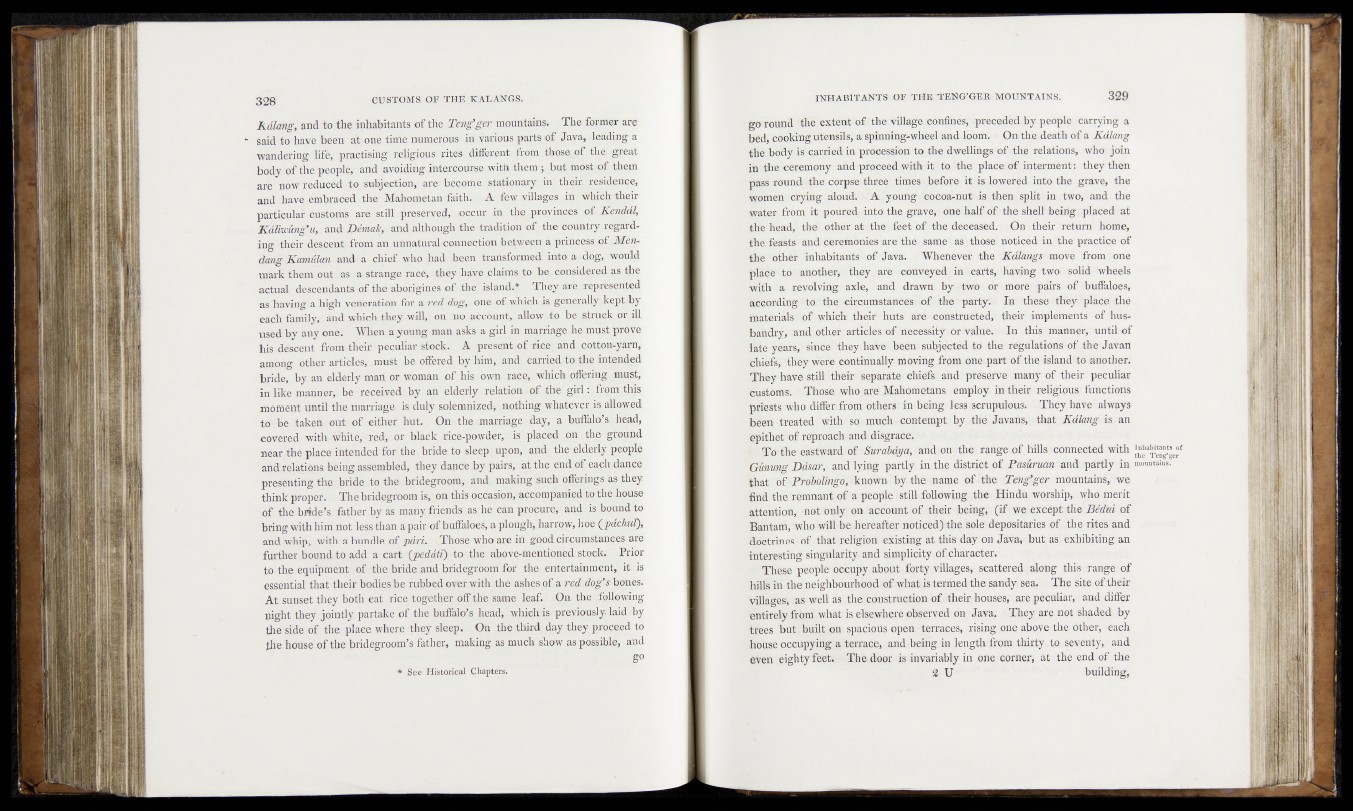
Kdlang, and to the inhabitants of tYi&<Tengger. Mountains. The former are
Said to have been at one time'numerous! in various ,parts <of Jaya; leading a
wandering-life, practising.-religious' rites, different, from ihose^of the.’, great
body rif the people, arid avoiding-intercourse with' them; butdno^tio£;'theiri
are now reduced to subjection,' are become stationary in' their .residence,
and have embraced'..the Mahometan faith. A few villages in whichitheir
particular customs. arerStill preserved, ;oecur in the^provinces of Kmddl,
Kdlmung’u,, and Demale, and although the tradition of th&ieountry,regarding
their descent from an unnatural connection between a princess ,ot, Men-
dang Kamdlan and a chief who had .been transformed* into a -dog, would
mark them out'.as. a strange race, they have claims to be -consumedra&,the
actual descendants of the aborigines of. „the,^island.* 'piej&ape represented
as 'having a high, .veneration for a red dog, \ offe- off which .-is generallyrkepj^by
each family,firid^hichJthey will,* on. .noi.acCount, allow to .bei isicucig ,^ 'd l
usedby any one. When-a young man^ks-a girl in marriage „he musfprove
his decent fr’om«their,peculiar stock.- A. presen^offEtc^ and.cotton-yarn,
among other .articles, must, be offered by him, and carried; t|&|he intended
bride, by an elderly man or woman of his own'-race;, whicE offering must,
in Jik.e manner,- be received by an elderly. relation. !p£ tlfe? girl:. from’: this
moment until the marriage is duly solemnized, -nothing whateve^is-,ai%§ed.
to;^he taken out. of either hut. On. the marriage day, -a. burial»V b£ad,
covered-with-white; red, or-black rice-powder, ./is'. placed *.Qn i.thergrourid
near the place intended for the bride to sleep; upon, and the^eldm]^ people
ariffrelations being assembled,. they dance by. pairs, fft the.c^d-ofceactedS.'^e
presenting the bride feo the-bridegroom, and making snefe dflferings^as-Jhfey
think proper. The bridegroom isy^on this occasion,' acmijupanied t^th^ho'use
of the bride’s father by as many friends as he’ can prppure, ~ and is'boundito
bring with him not less than a pair of buffaloes, a.plough,'harrow, hoe ppppfrtf),
and whip, with a bundle.of .pdri. . Those who are i&goodGiifcumstancesJare
further bound to. add a cart (peffari) to the above-meritipnjed.stock. Prior
to the equipment of .theibride.and bridegroom for the entertainment, it is
essential that their bodies be rubbeffoyeriwith the ash es o fh '.r^ h% ’®hpnes.
At sunset they both eat rice-together off the same leaf. On. theqf^lloiving
pight they jointly partake of the buflalo’s head; which is previously- laid!by
the side .of • Hp plaee where-they sleep. On the third day they proceed to
the house of. the bridegroom’s father, ■ making as much show asposffble, and 11 See Historical Chapters.
go round the ex-tent off th e tillage confines, preceded by people carrying a
bed; cooking utensils, a spinning-wheel and loom. On the death of a Kdlang
the bodyris' carried in procession to the dwellings, of ithe relations, who join
in the-ceremony and-proceed with it'to the place of interment: they then
pass round-the- corpse- three* times ^before" it is; lowered into the- grave, the
women crying-aloud.. A young cocoa-nut is then split-in two, and the
water JErom it pouredrinto the grave,"tone half of; the shell being placed, at
the’-head,'1 the-' other-at the-feet of the deceased.:1 Oh-their ^return home,
the1 feafsts and - eerefnbnies -are’ ithe, .same as'1 those -noticed .in. the practice of
the othei inhabitants of Java. Whenever the Kdlangs. move from-one
^fabe' to' another, they are coxiveyed -in carts, having two solid wheels
with a reyolving axle, and drawn’ by »ftwo' or more pSirs/ of buffaloes,
according1 td’^thelicireumstances^of'- the' "party. In these I th'ey-^place the
®aaterials'! of --which thleir1 hut's1' tate.* constructed, their -||rCpldm'fents of husbandry,
and--cither articles toff .necessity/ or-value. In this, manner, until: of
late |yeaTs7ilsinde they'have been; subjected to the regulations* of „the Javan
'Chiefs,f'they^wfere continually moving from-oneipart of the island, to another;
-They have-still‘their* separate chiefs ;and preserve -many off their peculiar
‘custoins: -Those whffare Mahometans employ ii»their religious functions
Infests-who differ from others in being: less-scrupulous. - They have always
been treated with much contempt*by the Javans, that Kdlang is* an
epitlbtioffrepXoaeh.andidisgracfe. ->
eastward of Surabdya, and on -tho rarige; off hills connected with
^&iiuwg Ddsar,< and'lying partly in the district of Pashruan"and - partly in
Hat off'PrdftoZBJ^d^knoWni by the-name of 'the Teng'ger mountains, ? we
find the remnant off*a>.pCpple :stilLfollowing ,the Hindu worship, who merit
attention, -not'only on -acCount of their .being,' (jiff, we except the: BMui of
Bantam, wdfoiwillbe.hereafter; noticed-),the "sole depositaries ioff-.the rites/ and
doctrines of-that religion existing at thisidayron Jaffay.'/but as^'exhibiting an
interesting singularity and simplicity offcharacter.'
‘These people occupy about forty villages,- scattered;along this -rangé of
hills'in-the1 neighbourhood of whatis termed the spndy. sea.. The site of .their
villages, as well as the cöustrücti'Onfbfiitheii;,h'ousesy are,peculiar, and differ
Entirely from; what is elsewhqrajoh^grved on Java. They are not shaded;,by
igfges but-built p;n. spacious open terraces, rising, »n^above the other, each
house occupying.ia.terrace, and being in lengthjfrom thirty to-seventy, and
even eighty feet. • The door is invariably in one corner, at the end of the
g U • building,